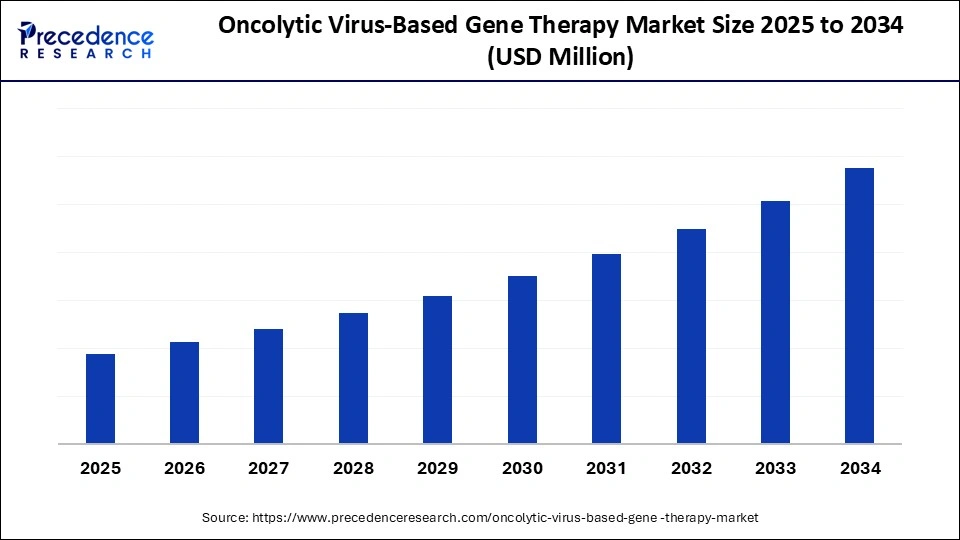Precision Therapies, AI-Driven Innovations, and Tumor-Targeting Viruses Ignite Growth in Cancer Gene Therapy
The global oncolytic virus-based gene therapy market is entering a high-growth era, expanding at an estimated fastest CAGR. This transformative sector is powered by advancements in viral engineering, surging cancer incidence rates, and the rise of combination immunotherapies, supported by regulatory momentum and technology breakthroughs.

What’s Driving Market Growth?
Oncolytic virus-based gene therapy leverages genetically modified viruses to selectively attack and destroy cancer cells while sparing healthy tissue. Fueled by robust R&D, the sector’s dual mechanism direct tumor lysis coupled with immune activation, addresses unmet needs in resistant solid tumors and aggressive cancers like melanoma and glioblastoma.
Oncolytic Virus-Based Gene Therapy Market Key Insights
-
North America led the market with about 45% share in 2024, driven by favorable FDA pathways and robust innovation.
-
Asia Pacific is poised as the fastest-growing region with a projected 15%+ CAGR.
-
Market dominance is held by pharmaceutical and biotechnology firms, commanding 50%+ of revenue due to clinical infrastructure and investment.
-
The leading segment by virus type is Herpes Simplex Virus (HSV), accounting for ~30% market share, while reovirus is rising rapidly at a projected 30% CAGR.
-
Intravenous administration is the top delivery route, making up 40% market share; intratumoral delivery grows fastest at +35% CAGR.
-
Melanoma represents the largest cancer application segment, with 25% share owing to successful clinical adoption.
-
Top market players: Amgen Inc., Replimune Group, Oncolytics Biotech, Sorrento Therapeutics, PsiOxus Therapeutics, Transgene SA, SillaJen Inc., Genelux Corporation, Shanghai Sunway Biotech, Takara Bio.
| Segment | 2024 Share / Trend |
|---|---|
| North America | 45% (Dominant) |
| HSV Virus | 30% (Leading) |
| Reovirus | 30% CAGR (Fastest Growing) |
| IV Delivery | 40% (Dominant) |
| Intratumoral | 35% CAGR (Fastest Growing) |
| Melanoma | 25% (Leading Cancer Type) |
| Pharma/Biotech | 50%+ (Top End User) |
| APAC Growth | 15%+ CAGR (Fastest Growing) |
AI drives a paradigm shift by optimizing the design and personalization of viral therapies. Instead of relying exclusively on laboratory trial and error, AI models use genomics and large molecular datasets to predict efficacy, enhance viral vector engineering, and offer personalized treatment plans while monitoring biomarkers for patient response. This rapid analysis accelerates clinical innovation, leading to faster and more targeted drug development for tough-to-treat cancers.
For example, researchers developed AI-powered models combining Generalized Lotka-Volterra equations and advanced optimization, enabling finer-tuned, patient-specific oncolytic therapy regimens. By enabling smarter candidate screening, AI is helping unlock the full therapeutic potential of gene therapy in oncology.
What Market Dynamics Are Fueling Growth?
Unrelenting cancer prevalence worldwide pushes demand for more effective, safer therapies. The distinctive benefit of oncolytic virus-based gene therapy, its selectivity for tumors and immune-priming ability, drives strong clinical and commercial momentum. The rise of combination strategies, especially with immune checkpoint inhibitors, is elevating response rates while technological advances in delivery (e.g., capsid modification, nanoparticle transport) vastly enhance efficacy and safety profiles.
What Emerging Trends and Opportunities Will Shape the Market?
How Are Technological Breakthroughs Targeting Drug Delivery Barriers?
Innovations like tumor-specific promoters, microRNA-responsive elements, and exosome-mediated transport are revolutionizing viral targeting, minimizing off-target toxicity, and overcoming immune clearance all hurdles that previously limited market success.
What Role Do Regulatory Advances and Regional Investments Play?
Proactive regulatory bodies (like the U.S. FDA with Fast Track and Breakthrough Therapy designations) and surging government-backed R&D in Asia-Pacific are catalyzing a clinical trial boom. This enables speedy approvals and early patient access—factors especially vital for rare, treatment-resistant cancers.
How Are Companies Accelerating Competitive Growth?
The sector is experiencing an uptick in licensing deals, clinical alliances, and acquisitions, with over 100 assets in development and next-gen, engineered virotherapies moving toward platform-level commercial opportunities.
Oncolytic Virus-Based Gene Therapy Market Regional and Segmentation Analysis
Regional Spotlight
-
North America holds the crown with top-tier R&D, a concentration of leading firms, and a favorable regulatory climate, notably benefiting from the U.S. FDA’s clear gene therapy pathways and expedited review mechanisms.
-
Asia Pacific is the growth engine, boasting rising healthcare expenditures, government incentives, and vibrant biotech clusters, particularly in China, Japan, and South Korea.
-
Canada’s research consortia such as COVCo and BioCanRx are advancing innovative trial models.
Segmentation Analysis
-
By virus type: HSV dominates thanks to engineering flexibility and clinical safety; reovirus is the rising star for tumor selectivity and combination potential.
-
By delivery: IV dominates but intratumoral delivery is becoming preferred for certain localized cancers due to higher local concentrations and synergistic effects with immunotherapies.
-
By cancer type: Melanoma is the prime target, but rapid pipeline developments in glioblastoma and other resistant solid tumors are expanding market reach.
-
By end-user: Pharma and biotech firms lead, leveraging sophisticated manufacturing and clinical trial capacity. Academic and research institutes are emerging as innovation powerhouses as public/private investment climbs.
Oncolytic Virus-Based Gene Therapy Market Top Companies
-
Amgen Inc. (Imlygic/T-VEC for melanoma)
-
Replimune Group (next-gen HSV therapies)
-
Oncolytics Biotech (pelareorep, reovirus)
-
Sorrento Therapeutics
-
PsiOxus Therapeutics
-
Transgene SA
-
SillaJen Inc.
-
Genelux Corporation
-
Shanghai Sunway Biotech (Oncorine)
-
Takara Bio
Challenges and Cost Pressures
Despite rapid progress, the market faces hurdles: achieving efficient systemic delivery in the face of immune clearance, high development/production costs, and securing access for rare cancer patients. Complex virus manufacturing, scale-up, and navigation of evolving regulatory standards add complexity, especially for smaller biotechs and global supply chains.
Case Study: North America’s Leadership in Regulatory Innovation
The 2015 FDA approval of T-VEC (Amgen Inc.) for melanoma set a precedent for global regulatory alignment. It validated virotherapy as a clinical reality and has since spurred a wave of trials and commercialization initiatives across leading U.S. and Canadian research hubs, propelling North America into a leadership role.
Read Also: In-Situ Hybridization Market
You can place an order or ask any questions. Please feel free to contact us at sales@precedenceresearch.com |+1 804 441 9344